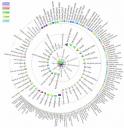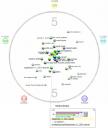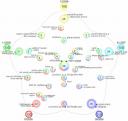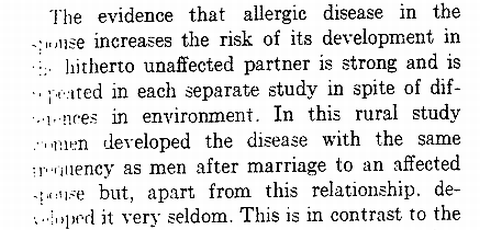Having identified earlier the largest problem in epidemiology I trying now to identify the second most relevant problem. Hopefully I can do it by just one sentence: Continue reading The second largest problem in epidemiology
3,93 mutations / Mb
1 MB is 1 Megabyte is 1,000,000 bytes and 1 Mb is 1 Megabase is 1,000,000 nucleotides. Although a new nature paper doesn’t make any fuss about it, there are 3,93 mutations / Mb in cancer tissues (in total they found 1,007 mutations by scanning 274 Mb from 210 cancer tissues). Continue reading 3,93 mutations / Mb
Errare humanum est
All4quotes and becontent have (mainly German) quotes. My all time favorites are
Aurelius Augustinus: Irren ist menschlich, aber aus Leidenschaft im Irrtum zu verharren, ist teuflisch.
August von Kotzebue: Menschen irren, aber nur große Menschen erkennen ihren Irrtum.
Christian Friedrich Hebbel: Die Menschheit läßt sich keinen Irrtum nehmen, der ihr nützt.
Friedrich von Schiller: Liegt der Irrtum nur erst, wie ein Grundstein, unter dem Boden, immer baut man darauf, nimmermehr kömmt er an den Tag.
Friedrich von Schiller: Hundertmal wer ich’s euch sagen und tausendmal: Irrtum ist Irrtum! Ob ihn der größte Mann, ob ihn der kleinste beging.
Georg Christoph Lichtenberg: Nur der Betrug entehrt, der Irrtum nie.
Does my partner cause my allergy?
A funny question answered in Allergy.
After adjustment for age, sex, parental predisposition and social status, the risk of hay fever was more than double in subjects who lived together with a partner having the same disease (odds ratio 2.4 […]). If subjects lived together with an affected partner, the risk of developing the disease increased with the time the partners lived together (1-11 years, OR 1; 12-23 years, OR 1.8; 24-35 years, OR 7.4; 36-54 years, OR 13.7).
Whatever that means – improved recall, shared doctor, non random mating, shared food, transmissible agent in descending order – it has been noticed already 40 years ago by Montgomery Smith and Lloyd Knowler in the Am Rev Resp Dis 1965; 92:16:
Finding Nemo
ATG16L1 is now confirmed as a candidate gene for Crohns disease:
Specifically, the LD structure and association mapping around the most associated SNP […] rs2241880 implicated a region on chromosome 2q37.1 containing a single gene known as ATG16 autophagy–related 16-like 1 (ATG16L1) […] Logistic regression analyses conditional on A197T in the family-based samples indicated that this coding variant can fully explain the association signal to this locus; thus, we consider this to be the causal risk variant.
Excellent to have this replication, although the argument above cannot convince me that this already a causal variant.
ATG16L1 seems to be most abundant in CD4+ and CD8+ cells and knockdown of the gene will lead to loss of S. typhimurium autophagy. Does rs2241880 really induce a loss of function and how does it relate to TLR7 and NOD2/CARD15 signalling?
The authors of another Nature paper believe that there is a primary NF-kB signalling defect in the Toll-like receptor activation by intestinal bacteria – see also KEGG pathways.
It will be much easier now to ask the right questions.
A new pharmacogenomic approach
Already some time on my desk – a highly interesting pharmacogenomics approach published in issue 1 of PLoS 1. By comparing the muscle transcriptome with the plasma lipidome the authors tried to map a suspected pathway leading to statin-induced myopathy. Continue reading A new pharmacogenomic approach
Filaggrin makes its way
A 3rd paper in nature genetics details the filaggrin gene structure: exon 3 has 10 repeats (as well as three variants FLG8+, FLG10+, FLF8+10+) and 15 SNPs – one of the few success stories in allergy research. In the discussion section, they ask the rhetoric question:
This study raises questions of interest to the complex trait field. Would SNP tagging of these multiple, relatively rare alleles, with frequencies no greater than 0.013, have readily identified this particularly strong susceptibility gene?
Nay, nay.
When are we being sensitized?
JACI has a paper in press that addresses this important question. The background is that allergen induced T-cell reactivitiy has been shown in cord blood – a strong argument that sensitization occurs transplacentally. Genotyping of these cells confirmed their fetal origin. It is unclear, however, if this is only a transient (normal?) reaction – and mothers want to know if they need to avoid for example peanuts during pregnancy. Rowe et al. now arrive at a clear conclusion Continue reading When are we being sensitized?
Blogiquette
O’ Reilly has drafted a blogger’s code of conduct. Here are my first thoughts:
1. We take responsibility for our own words and for the comments we allow on our blog.
always, if not being influenced by C2H5OH Continue reading Blogiquette
Search for crystals
First monday has an interesting paper on the 100 most visited Wikipedia pages for the period of September 2006 to January 2007 (Wikipedia is the ninth most visited site in the U.S. with 43 million visitors). The crystal search link in the paper does not work but the table reports that science ranks at place 5 – not too bad.



PDF batch printing
I have been batch printing PDFs for years with the built-in macro function of the Adobe Reader. For any unknown reason this doesn´t work anymore with my current OS / PDF / printer combination. The printer queue is always stuck or even detaches. I have therefore looked for a solution to delay the printing process. Most print utilitites do not help as I can´t delay spooling of print jobs. Here is my final solution – I am starting Acrobat first and send by DDE in long intervals a print command via pdfp
1: | |
More blogging conferences
We also have some local events here. Following the wizards-of-os last September (and the famous “I have been building a meme about read-write vs. read-only society” by Lawrence Lessing) the re-publica conference takes place in Berlin – culture / society / technical / business / other – but no science as far as I can see.
The sunshine cure
Nature medicine news has a short text about the sunshine cure.
The strongest evidence available is perhaps for the vitamin’s protective role in MS. Several studies have documented a dramatic ‘sunshine belt’ […] Latitude also seems to play a role in the incidence of hormone-dependent cancers. […] The effect is almost certainly because of vitamin D, Feldman says. “People tend to think it can’t do all these things when it’s a vitamin,” notes Feldman. “It’s not a vitamin, it’s a hormone.”
As always there seems no fun without risk. We could add links to arteriosclerosis and allergy.
Science and religion
Wikiquote has already a large collection:
* “All religions, arts and sciences are branches of the same tree.” – Albert Einstein
* “The antagonism between science and religion, about which we hear so much, appears to me purely factitious, fabricated on the one hand by short-sighted religious people, who confound […] theology with religion; and on the other by equally short-sighted scientific people who forget that science takes for its province only that which is susceptible of clear intellectual comprehension.” – Thomas Henry Huxley (1825–1895), “The Interpreters of Genesis and the Interpreters of Nature” (1885)
CV Adelsberger
I have completed today the collection of all writings of Lucie Adelsberger, a well known allergy specialist in pre-war Berlin before she was sent to Auschwitz. The following CV is taken from her thesis in 1920: Continue reading CV Adelsberger
